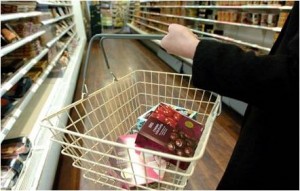By Joel Rubinson
Traditional marketing theory tells us that the purchase is the successful outcome of consumer-directed messages that create awareness which begets interest, desire, and action.
What happens when that is wrong? What does marketing do when it STARTS with the purchase?
This is an extreme version of what Procter calls “store back”. However, based on shopper insights research I have conducted, I believe that, for grocery products, over half of first-time purchases are unplanned; in fact, the shopper might not even have been aware of the product before buying it. In those cases, it all STARTS with the purchase and ENDS with awareness. The purchase funnel is totally flipped.
When it all starts with the purchase, the role of marketing communications changes. Now marketing must get the product noticed at shelf and impart meaning to it instantaneously for the shopper. Packaging, shelf placement, thematic displays, signage, mobile messages that are location-aware, shopper offers based on that shopper’s history, and master brand familiarity become the main vectors for creating meaning. In this communications model, when someone encounters a product they were unfamiliar with they should be able make sense of it instantly; to tell YOU (the marketer) what the product is about, rather than you having to tell them in a concept statement. After the product is bought and being used, there is more sense-making that occurs. If the consumer is really into the product as they are using it, now you have an opportunity to build engagement: they might join a community, become a fan in Facebook, share comments, start seeking out advertising and recalling it, seek out the brand’s “creation story”, etc. In this scenario, the impact of brand narrative, brand values, social media engagement, etc. come AFTER the purchase, so they solidify rather than precondition the brand-customer relationship.
Could it really be that it all starts with the purchase? Well, for certain types of products and retailing situations, I believe it does. Consider this:
- – Conduct a study to measure the percent of products bought for the first time that are discovered in-store (I got 50%+)
- – Do you think the products bought for the first time on impulse in a Kroger’s, Trader Joes, Costco, Target, etc. are all the same and were previously known? If not, then you believe that brand adoption can START via the shopping experience.
- – Consider shopping styles that people have, reflecting their relationship with a product category. Can you imagine categories (e.g. artisan cheeses) where shoppers like to explore and find new interesting products to buy?
This last point is perhaps the most important. People have different shopping styles for different product categories which means that the heuristics they use to make decisions are systematic. You might not ever buy carbonated soft drinks the way you buy interesting dips that you just tried at a tasting station. This is where behavioral economics intersects marketing; the study of how people decide is often more interesting than theoretical purchase intentions. Hence, some products will predominantly be bought via a process that starts in-store. Others will be bought based more on the traditional marketing model requiring awareness built via mass media. You need to study HOW people decide in order to understand when to start from the traditional end of the funnel and when you start from the other end of the funnel.
When it all STARTS with the purchase, everything that you thought was upstream becomes downstream and the thing that was the most downstream of all, the purchase, becomes the most upstream event.
This is “store back” on steroids.
Now, the researcher in me has to ask the rhetorical question, “Does the marketing community have the research tools to act on this new way of thinking?” Rhetorical because, I don’t think we do.
____________________________________________________________________________________________
Joel Rubinson is a distinguished expert in consumer and market research and the President of Rubinson Consulting. He can be reached at joelrubinson@gmail.com
____________________________________________________________________________________________

